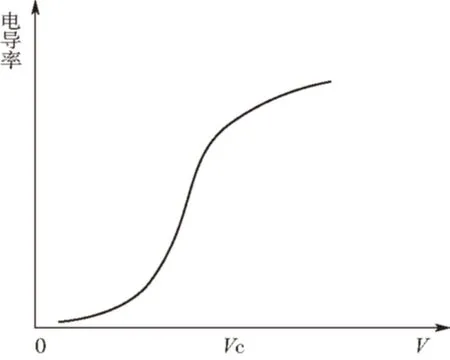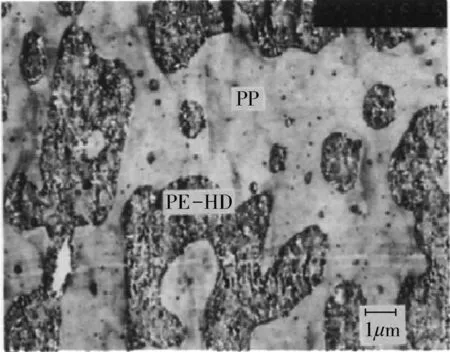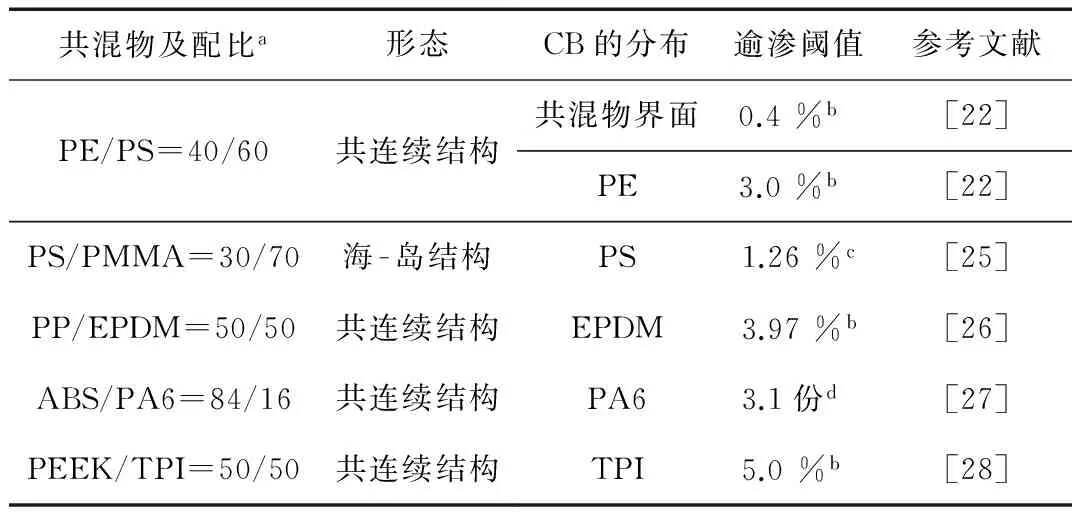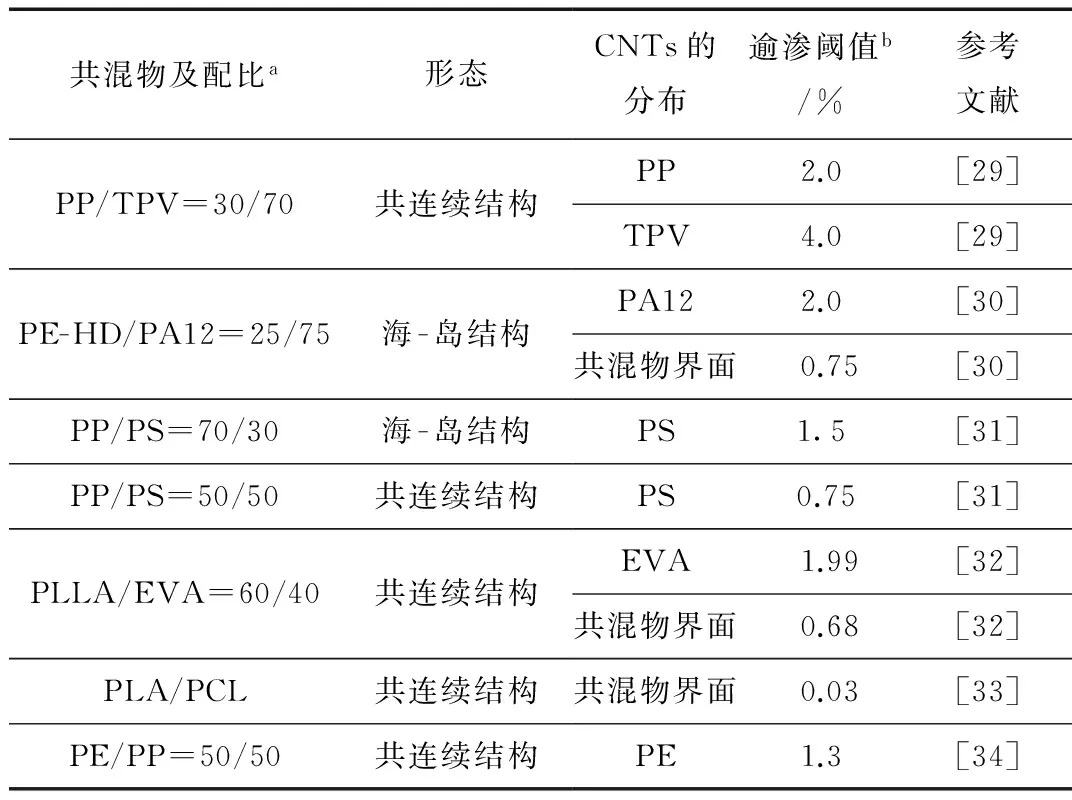双逾渗结构碳系填充导电高分子复合材料的研究进展
王 英
[山西省化工研究所(有限公司),山西 太原 030001]
双逾渗结构碳系填充导电高分子复合材料的研究进展
王 英
[山西省化工研究所(有限公司),山西 太原 030001]
综述了导电高分子复合材料(CPCs)导电性能的逾渗理论和双逾渗机理,阐述了以碳材料为导电填料的具有双逾渗结构的CPCs的研究进展,其填料主要包括炭黑、碳纳米管;展望了双逾渗结构CPCs的研究前景。
炭黑;碳纳米管;双逾渗结构;逾渗阈值;导电性;复合材料
0 前言
探索和发展CPCs制备的新方法,以保证在具有良好导电功能的情况下,降低导电逾渗阈值、获得良好力学性能、加工性能和电性能且电性能不受成型加工外场影响或影响极小的CPCs理论和应用已成为研究重点和热点[1]。截止目前,研究者具体开发了诸多方法来降低CPCs的逾渗值,如隔离结构导电[2]、多逾渗(其中最常用的为双逾渗)[3]、在基体聚合物合成过程中原位加入导电填料[4-5]、多层共挤出[6]、泡孔结构CPCs[7-9]、静电纺丝技术[10-11]、原位微纤化[12]等。相对于其他方法,双逾渗现象由于具有以下优势而表现出独特的优越性:(1)减弱体系负温度系数(NTC)现象[13-15];(2)改善导电复合材料的加工性能及力学性能[16-17];(3)降低材料的体积电阻率及炭黑(CB)的逾渗阈值[18-20]。本文以CB和碳纳米管(CNTs)为例,对碳系填充双逾渗结构的CPCs进行了研究。
1 逾渗理论和双逾渗机理
1.1 逾渗理论
CPCs是将导电填料如CB、CNTs、碳纤维(CF)、石墨或金属粉末等一种或几种导电填料分散到一相或多相高分子基体中制得的复合材料。在CPCs中当填料含量超过某一临界值时,材料的电导率将急剧上升,并发生从绝缘体到导体的转变,将此现象称为逾渗现象[21],可用图1表示。设基体中填料所占的体积分数为V,Vc为逾渗阈值。当0

图1 CPCs的逾渗现象Fig.1 Percolation phenomenon of CPCs
1.2 双逾渗机理
以上是导电填料填充单相聚合物基体的逾渗理论,而导电填料在多相体系中可能出现不均匀分布的现象,这种不均匀分布存在2种可能的情况:一种是导电粒子与某一相亲和性较好,界面张力小,几乎全部分散在其中,如图2所示在双逾渗结构聚丙烯(PP)/高密度聚乙烯(PE-HD)/CB复合材料中,CB选择性分布在PE-HD相中;另一种是导电粒子优先在相界面中分布。Sumita[22]在研究CB填充PE-HD/PP和PP/聚甲基丙烯酸甲酯(PMMA)复合材料的分散情况后首先提出了双逾渗的概念。其含义为第一层次的逾渗是CB在其富集相或界面内形成微导电网络,第二层次的逾渗是CB富集相或界面在整个基体内形成宏观导电网络。因此双逾渗现象大大促进了微导电链及宏观导电网络的形成,使复合材料导电的逾渗阈值大幅度下降。

图2 双逾渗结构PP/PE-HD/CB复合材料的微观结构(10000×)Fig.2 Typical morphology of PP/PE-HD/CB with double percolation structure
2 碳材料双逾渗结构CPCs的研究现状
2.1 CB填充型
CB是目前应用最广、用量最大的导电填料,其体积电阻率为0.1~10 Ω·cm,导电性能稳定持久,可大幅度调整复合材料的导电性能(1~1×108Ω·cm)。通常,CB填充型共混物导电复合材料的逾渗阈值会随基体连续度的增加而降低[23]。不同CB填充型共混物导电复合材料的逾渗阈值如表1所示。
Wu等[24]将CB加入到ABS/PA6的共混物中,通过调整PA6与ABS的比例,发现当ABS/PA6的共混比例为60/40时,体系具有最大的连续度,此时复合材料对应着最低的逾渗值。此外,研究表明,当CB选择性分布在具有双连续结构不相容共混物的相界面处时,材料的逾渗值会进一步降低[22]。

表1 不同CB填充型共混物导电复合材料的逾渗阈值Tab.1 Percolation threshold of conductive composites filled with different carbon black blends
注:EPDM为三元乙丙橡胶,ABS/PA6为丙烯腈 - 丁二烯 - 苯乙烯共聚物/聚酰胺6,PEEK/TPI为聚醚醚酮/热塑性聚酰亚胺;a为质量比;b为质量分数;c为体积分数;d为质量份。
Liu等[25]在制备PS/PMMA/CB导电复合材料时发现,CB含量增加到一定量时会使不相容聚合物的相形貌发生转变。如图3所示,当PS/PMMA的共混比例为30/70时,两相呈现海 - 岛结构[图3(a)],在PS/PMMA/CB导电复合材料中,CB选择性分布在PS相中,因此,随着CB含量的增加,体系中PS的黏度增大,当CB的体积含量达到4 %时,体系呈现的是共连续结构,PS/CB复合材料中,逾渗阈值为2.5 %(体积分数)。当PMMA的体积含量达到70 %时,复合材料的逾渗阈值为1.26 %(体积分数)。

CB体积含量/%:(a)0 (b)1 (c)2 (d)4图3 PS/PMMA(30/70)混合物的冷沉淀断裂面的SEM照片Fig.3 SEM of cryo-fractured surfaces of PS/PMMA(30/70) blends
目前,虽然CB填充型共混物导电复合材料取得了长足的发展,但是对其导电性以及CB分布的理论研究尚不完善。此外,这类材料的基体一般为呈现双连续结构的不相容共混物,因而使得复合材料的力学性能有所降低。因此,开展这方面的研究对CB填充型共混物导电材料而言十分必要。
2.2 CNTs填充型

以PLLA/CNTs为母粒的EVA/PLLA/CNTs=40/60/1复合材料放大倍数:(a)100× (c)1000×以EVA/CNTs为母粒的PLLA/EVA/CNTs=60/40/1复合材料放大倍数:(b)100× (d)1000×图4 CNTs在不同复合材料和不同放大倍率下分布的SEM照片Fig.4 SEM showing location of CNTs in different composites at different magnifications
CNTs是完全由碳原子组成的一种直径处于纳米级的一维管状纳米材料。与传统碳系导电填料相比,CNTs具有更为优异的导电性和强度,将CNTs添加到不相容共混物中将得到导电性更加突出的CPCs。大量研究者将CNTs添加到不相容共混物中,得到了一系列逾渗值不同的CNTs填充型导电复合材料,结果如表2所示。从表中可看出,CNTs填充型共混物导电复合材料的逾渗阈值与共混物相形貌和CNTs的分布状况密切相关。

表2 不同CNTs填充型共混物导电复合材料的逾渗阈值Tab.2 Percolation threshold of conductive composites filled with different carbon nanotubes blends
注:TPV为热塑性三元乙丙动态硫化橡胶;PA12为聚酰胺12;PLLA/EVA为聚左旋乳酸/乙烯 - 醋酸乙烯共聚物; PLA/PCL为聚乳酸/聚ε - 己内酯;a为质量比;b为质量分数。
Zonder等[30]发现在通过PE-HD/多壁碳纳米管(MWCNTs)母料制备的具有海 - 岛结构的PA12/PE-HD/MWCNTs复合材料中,MWCNTs选择性分布在共混物的相界面处时,复合材料的逾渗阈值为0.75 %(质量分数),低于MWCNTs选择性分布在PA12中的逾渗值(2 %,质量分数)。Hwang等[31]将CNTs加入到PP/PS共混物中制备了导电复合材料。结果表明,当共混物呈现双连续结构时,材料的逾渗阈值约为0.75 %(质量分数),低于以海 - 岛结构为基础得到的逾渗值1.5 %(质量分数)。另外,CNTs分布情况的不同也会影响复合材料的逾渗值,当CNTs分布在共混物的相界面处时,复合材料的逾渗值会进一步降低。同样,Shi等[32]通过改变加工顺序制备了具有双连续结构的PLLA/EVA/CNTs复合材料。结果表明,在以PLLA/CNTs为母料的样品中,CNTs选择性分布在共混物相界面处,对应的逾渗值为0.68 %(质量分数);而在EVA/CNTs为母料的样品中,CNTs则选择性分布在EVA中,且材料的逾渗值为1.98 %(质量分数)。材料的扫描电子显微镜(SEM)和透射电子显微镜(TEM)照片如图4、5所示,其中EVA在SEM测试前通过正庚烷去除,且CNTs在复合材料中的质量分数为1 %;在TEM照片中CNTs在复合材料中的质量分数为2 %。

以PLLA/CNTs为母粒的EVA/PLLA/CNTs=40/60/2复合材料:(a)典型分布 (c)相应分布以EVA/CNTs为母粒的PLLA/EVA/CNTs=60/40/2复合材料:(b)典型分布 (d)相应分布图5 CNTs在不同复合材料中分布的TEM照片和模型图Fig.5 TEM and model images showing localization of CNTs in different composites
从表1和表2对比可以看出,用CNTs填充的导电复合材料的逾渗值明显低于用CB填充的导电复合材料。由此可见,导电率的高低除了与填料在基体中的分散状态有关外,还与填料的形貌密切相关。一维的CNTs比零维CB更有利于导电性能的提高。
3 双逾渗结构CPCs的研究进展
近年来,双逾渗导电高分子材料在2个方面获得了重要进展。一方面是可通过计算机模拟手段控制预测导电填料在聚合物基体中选择性分布[35-37];另一方面是利用新型填料(石墨烯、镀镍碳纤、镀镍玻纤等)来制备双逾渗导电高分子材料[38]。
Yasser等[39]结合聚合物/碳纳米管纳米复合材料(PCNT)界面的增强功效和逾渗效应,研制出了用于拉伸模量的微观力学模型,该模型认为界面逾渗通过相同的厚度可提高PCNT的模量,同时CNTs的半径和长度可能影响纳米粒子的逾渗阈值和填料网状物的浓度。Kelsey等[40]探讨了多分散混合物中逾渗阈值预测的分析方法,该方法扩展了排除体积的概念,并将其应用于二维二进制磁盘系统,用于设计复合材料。Zhang等[41]使用分子动力学模型研究了聚合物 - 纳米棒相互作用下,纳米棒的纵横比、块刚度和外部张力对二嵌段共聚物纳米复合材料的微观结构和电学性能的影响。结果表明,各向异性的纳米棒在具有轻微单轴取向的连续嵌段中的连续定位可显著降低逾渗阈值。Sima等[42]通过将石墨烯纳米片(GNP)分散在聚对苯二甲酸丁二醇酯 - 对苯二甲酸酯(PBAT)中制备了一系列可生物降解的纳米复合材料。结果表明,逾渗不仅起源于片晶之间的网络形成,而且可能与组合的PBAT/GNP凝胶网络相关,PBAT/GNP凝胶网络随着温度升高而增强,导致其在提高温度时更像固体反应。纳米复合材料的剪切黏度随温度的变化也表明,增加GNP负载降低了黏度的温度敏感性,导致纳米复合材料的相对黏度随温度升高而增加。Li等[43]研究了一种具有隔离网络结构的热还原石墨烯氧化物/硅藻土复合材料的新制备方法。在硅藻土中混合质量分数为13 %的玻璃粉,并利用硅藻土颗粒包覆氧化石墨烯原位热还原法制备了导电复合材料,其逾渗阈值体积分数为0.229 %。同时,硅藻土的最高压缩强度从11.3 MPa增加到了21.1 MPa。 Lu等[44]使用2步法造纸/热黏合工艺合成了一种高柔性、高导电性的无纺布,称为PP/PE/碳纤维(CF)并排纤维(ESF)无纺布(CEF-NF),其作为电磁干扰(EMI)屏蔽材料,具有良好的力学强度、优异的柔韧性、超薄性以及显著的电学性能。通过SEM对纯CF非织造织物和CEF-NF进行全面表征,可了解和验证由于引入ESF而导致的拉伸强度的改善;通过测量CEF-NF的电导率以阐明热压效应,并研究其在增强CEF-NF导电性能中的重要性。结果发现,CEF-NF的电导率随着CF长度的增加和体积密度的增加而增大。从电导率和CF体积密度关系模型中确定了CEF-NF的CF体积密度逾渗阈值。GUO等[45]通过镀镍玻璃纤维制成了具有低逾渗值的导电PP复合材料。玻璃纤维较高的纵横比使之可以轻松地和聚合物连接从而构建聚合物基质中的网络结构,因此玻璃纤维表面导电镍涂层成功地形成了一个连续的导电网络,以相对较低的镍含量(1.17 %)就可得到导电性良好的复合材料(8.7 S/cm),并且导电复合材料的逾渗阈值低至0.46 %(体积分数)。
4 结语
双逾渗理论提出导电填料分布在不相容聚合物中的一相或两相界面处,极大地降低了导电复合材料的逾渗值,并减弱了体系NTC现象,改善了导电复合材料的加工性能及力学性能;在双逾渗结构CPCs中,导电填料富集相的导电网络和此富集相在另一种聚合物基体中的连续程度是整个体系导电网络形成的关键所在,目前关于双逾渗结构导电复合材料研究较多的是以CB、MWCNTs为填料,关于CF的研究较少;此外具有双逾渗结构的CPCs基体一般为双连续结构的不相容共混物,材料的力学性能有所降低;因此,开展这方面的研究对碳系填充型共混物导电材料而言十分必要。
[1] Dai K, Xu X B, Li Z M. Electrically Conductive Carbon Black (CB) Filled in Situ Microfibrillar Poly(ethylene terephthalate)(PET)/Polyethylene(PE) Composite with a Selective CB Distribution[J].Polymer, 2007, 48(3): 849-859.
[2] Ou R Q,Gupta S,Parker C A,et al.Fabrication and Electrical Conductivity of Poly(methylm ethacrylate)(PMMA)/Carbon Black(CB) Composites:Comparison Between an Ordered Carbon Black Nanowire-like Segregated Structure and a Randomly Dispersed Carbon Black Nanostructure[J].J Phys Chem B,2006,110:22365-22373.
[3] Sumita M,Sakata K,Hayakaw Y,et al.Double Percolation Effect on the Electrical Conductivity of Conductive Particles Filled Polymer Blends[J].Coll Polym Sci,1992,270(2):134-139.
[4] Hu J W, Li M W, Zhang M Q,et al.Preparation of Binary Conductive Polymer Composites with Very Low Percolation Threshold by Latex Blending[J].Macromol Rapid Comm,2003,24(15): 889-893.
[5] Zhang B,Fu R W,Zhang M Q,et al.Preparation and Cha-racterization of Gas-sensitive Composites from Multi-walled Carbon Nanotubes/Polystyrene[J]. Sensor Actuat B:Chem,2005,109(2): 323-328.
[6] Xu S X,Wen M,Li J,et al.Structure and Properties of Electrically Conducting Composites Consisting of Alternating Layers of Pure Polypropylene and Polypropylene with a Carbon Black Filler[J].Polymer,2008,49(22):4861-4870.
[7] Thompson M R,Motlagh G H,Oxby K J,et al.Multiple Percolation in a Carbon-filled Polymer Composites via Foaming[J].J Appl Polym Sci, 2010, 115(2): 646-654.
[8] Rizvi R, Kim J, Naguib H.Synthesis and Characterization of Novel Low Density Polyethylene-multiwall Carbon Nanotube Porous Composites[J].Smart Mater Struct, 2009, 18(10):104002.
[9] Xu X B,Li Z M,Shi L,et al.Ultralight Conductive Carbon-nanotube-polymer Composite[J]. Small,2007, 3(3): 408-411.
[10] Hunley M T,Potschke P,Long T E.Melt Dispersion and Electrospinning of Non-functionalized Multiwalled Carbon Nanotubes in Thermoplastic Polyurethane[J].Ma-cromol Rapid Comm,2009, 30(24): 2102-2106.
[11] Kim H S,Jin H J,Myung S J,et al.Carbon Nanotube-absorbed Electrospun Nanofibrous Membranes of Nylon 6[J].Macromol Rapid Comm, 2006, 27(2):146-151.
[12] Kiss G.In Situ Composites:Blends of Isotropic Polymers and Thermotropic Liquid Crystalline Polymers[J].Polym Eng Sci, 2010,27(6): 410-423.
[13] Lee G J, Suh K D, Im S S. Effect of Incorporating Ethy-lene-ethylacrylate Copolymer on the Positive Temperature Coefficient Characteristics of Carbon Black Filled HDPE Systems[J].Polymer Engineering & Science, 2000, 40(1): 247-255.
[14] Tang H,Piao J,Chen X, et al.The Positive Temperature Coefficient Phenomenon of Vinyl Polymer/CB Compo-sites[J].Journal of Applied Polymer Science, 1993, 48(10): 1795-1800.
[15] Feng J, Chan C. Carbon Black-filled Immiscible Blends of Poly(vinylidene fluoride) and High Density Polyethylene:The Relationship Between Morphology and Positive and Negative Temperature Coefficient Effects.[J].Polymer Engineering & Science, 1999, 39(7):1207-1215.
[16] Zhang M Q, Yu G, Zeng H M, et al. Two-step Percolation in Polymer Blends Filled with Carbon Black[J]. Macromolecules,1998,31(19): 6724-6726.
[17] Chen J,Shi Y,Yang J,et al.A Simple Strategy to Achieve Very Low Percolation Threshold via the Selective Distribution of Carbon Nanotubes at the Interface of Polymer Blends[J].J Mater Chem,2012,22(42):22398-22404.
[18] Feng J,Chan C,Li J A.Method to Control the Dispersion of Carbon Black in Immiscible Polymer Blend[J].Polymer Engineering and Science,2003,43(5):1058-1063.
[19] A vlyanov J K,Schwartz K,Gerteisen S R, et al.Self-organized Networks of Intrinsically Conductive Additives in Two-phase Plastics[J].Nursing Standard, 1999, 102(1):1274-1274.
[20] F Gubbels,R Jerome,P Teyssie,et al.Selective Localization of Carbon-Black in Immiscible Polymer Blends a Useful Tool to Design Electrical Conductive Composites[J].Macromolecules,1994,27(7):1972-1974.
[21] 张荣炜,刘凤岐.炭黑/聚合物复合材料的研究进展[J].高分子材料科学与工程,2005,21(3):45-49. Zhang Rongwei,Liu Fengqi.The Research Progress of Carbon Black/Polymer Composites[J].Polymer Materials Science&Engineering,2005,21(3):45-49.
[22] Gubbels F,Jerome R,Teyssie P.Selective Localization of Carbon Black in Immiscible Polymer Blends:A Useful Tool to Design Electrical Conductive Composites[J]. Macromolecules, 1994,27(7):1972-1974.
[23] Tchoudakov R,Breuer O,Narkis M,et al.Conductive Polymer Blends with Low Carbon Black Loading:High Impact Polystyrene/Thermoplastic Elastomer(styrene-isoprene-styrene)[J].Polymer Engineering & Science, 1997,37(12):1928-1935.
[24] Wu G,Li B,Jiang J.Carbon Black Self-networking Induced Co-continuity of Immiscible Polymer Blends[J]Polymer, 2010,51(9):2077-2083.
[25] Pan Y,Liu X,Hao X,et al.Enhancing the Electrical Conductivity of Carbon Black-filled Immiscible Polymer Blends by Tuning the Morphology[J]. European Polymer Journal, 2016, 78: 106-115.
[26] Ma L F, Bao R Y, Huang S L,et al.Electrical Properties and Morphology of Carbon Black Filled PP/EPDM Blends:Effect of Selective Distribution of Fillers Induced by Dynamic Vulcanization[J].Journal of Materials Science,2013, 48(14):4942-4951.
[27] Wu G Z, Li B P, Jiang J D.Carbon Black Self-networking Induced Co-continuity of Immiscible Polymer Blends[J].Polymer,2010,51(9):2077.
[28] Gao C,Zhang S, Lin Y,et al.High-performance Conductive Materials Based on the Selective Location of Carbon Black in Poly(ether ether ketone)/Polyimide Matrix[J].Composites Part B:Engineering,2015,79:124-131.
[29] Zhu Y,Zhang X,Song Z,et al.The Effect of Selective Location of Carbon Nanotubes on Electrical Properties of Thermoplastic Vulcanizates[J].Journal of Applied Polymer Science,2013,127(5):3885-3890.
[30] Zonder L,Ophir A,Kenig S,et al.The Effect of Carbon Nanotubes on the Rheology and Electrical Resistivity of Polyamide 12/High Density Polyethylene Blends[J].Poly-mer, 2011,52(22):5085-5091.
[31] Hwang T Y,Yoo Y,Lee J W.Electrical Conductivity,Phase Behavior,and Rheology of Polypropylene/Polystyrene Blends with Multi-walled Carbon Nanotube[J].Rheologica Acta, 2012,51(7):623-636.
[32] Shi Y Y,Yang J H,Huang T,et al.Selective Localization of Carbon Nanotubes at the Interface of Poly(L-lactide)/Ethylene-co-vinyl Acetate Resulting in Lowered Electrical Resistivity[J].Composites Part B:Engineering,2013,55(9):463-469.
[33] Gubbels F,Jerome R,Vanlathem E,et al.Kinetic and Thermodynamic Control of the Selective Localization of Carbon Black at the Interface of Immiscible Polymer Blends[J].Chemistry of Materials,1998,10(5):1227-1235.
[34] Gao X,Zhang S M.Preparation of High Performance Conductive Polymer Fibres from Double Percolated Structure[J].Journal of Materials Chemistry,2011,21(17):6401-6408.
[35] I Alig,P Pötschke,D Lellinger,et al.Villmow,Establishment, Morphology and Properties of Carbon Nanotube Networks in Polymer melts[J]. Polymer,2012, 53(1): 4-28.
[36] V K Daga,E R Anderson,S P Gido,et al.Hydrogen Bond Assisted Assembly of Well-ordered Polyhedral Oligome-ric Silsesquioxane-block Copolymer Composites[J].Ma-cromolecules,2011,44(17):6793-6799.
[37] Pan Y,Li L,Chan S H,et al.Reinforcing Effects of Kevlar Fiber on the Mechanical Properties of Wood-flour/High-density-polyethylene Composites[J]. Compos Part A:Appl Sci,2010,41(9):1272-1278.
[38] Li M K, Gao C X, Zhang X,et al.Electrical Conductivity of Calcined Graphene Oxide/Diatomite Composites with a Segregated Structure[J].Materials Letters,2015, 141(15):125-127.
[39] Yasser Zare,Kyong Yop Rhee.Accounting the Reinforcing Efficiency and Percolating Role of Interphase Regions in Tensile Modulus of Polymer/CNT Nanocompo-sites[J].European Polymer Journal,2017,87:389-397.
[40] Kelsey Meeks,Michelle L,Micah Green,et al.Extending the Excluded Volume for Percolation Threshold Estimates in Polydisperse Systems:The Binary Disk System[J].Appiled Mathematical Modelling,2017,46:116-125.
[41] Zhang S C,Feng Y C,Ning N Y,et al.Effects of Dispersion and Orientation of Nanorods on Electrical Networksoft Block Copolymer Nanocomposites[J].Computational Materials Science,2017,129:107-114.
[42] Sima Kashi,Rahul Gupta,Nhol Kao,et al.Viscoelastic Properties and Physical Gelation of Poly(butyleneadipate-co-terephthalate)/Grapheme Nanoplatelet Nanocompo-sites at Elevated Temperatures[J].Polymer,2016,101:347-357.
[43] Li M K,Gao C X,Zhang X,et al.Electrical Conductivity of Calcined Graphene Oxide/Diatomite Composites with a Segregated Structure[J].Materials Letters,2015,141:125-127.
[44] Lu L S,Xing D,Xie Y X,et al.Electrical Conductivity Investigation of a Nonwoven Fabric Composed of Carbon Fibers and Polypropylene/Polyethylene Core/Sheath Bicomponent Fibers[J].Materials and Design,2016,112:383-391.
[45] Guo C,Duan H J,Dong C Y,et al.Preparation of the Po-lypropylene/Nickel Coated Glass Fibers Conductive Composites with a Low Percolation Threshold[J].Materials Letters,2015,143(16):124-127.
Research Progresses in Conductive Carbon-based PolymericComposites with Dual-percolation Threshold
WANG Ying
[Shanxi Provincial Institute of Chemical Industry (Co, Ltd), Taiyuan 030001, China]
This paper introduced the mechanisms of percolation and dual-percolation thresholds for conductive carbon-based polymeric composites and reviewed the research progresses in the conductive polymeric composites with a dual-percolation threshold, in which carbon materials mainly including carbon black and carbon nanotubes were used as conductive fillers. The development trend of conductive polymeric composites with dual-percolation threshold was prospected.
carbon black;carbon nanotube; dual-percolation feature; percolation threshold; electrical conductivity; composite
2017-02-23
TQ327.8
B
1001-9278(2017)08-0018-06
10.19491/j.issn.1001-9278.2017.08.003
联系人,ztzyz615@163.com

